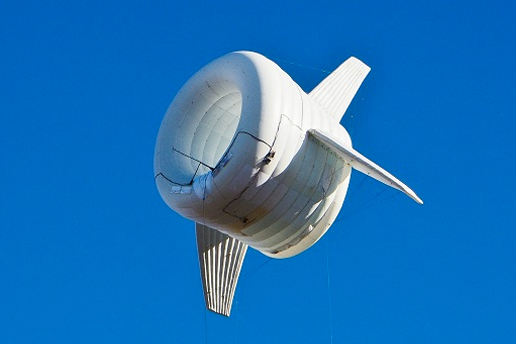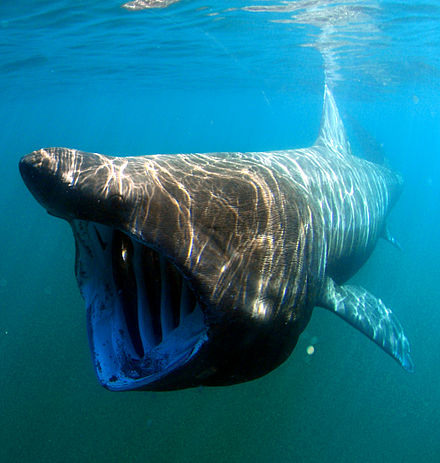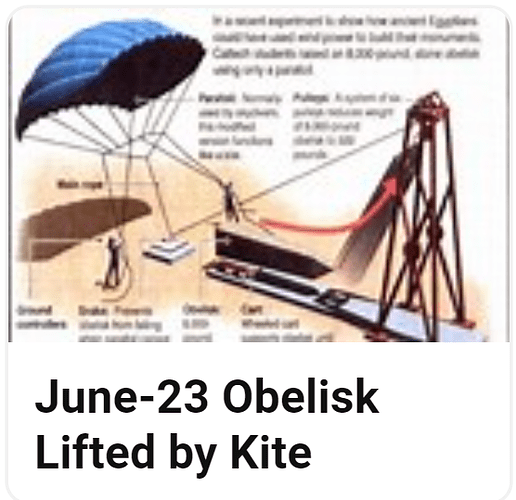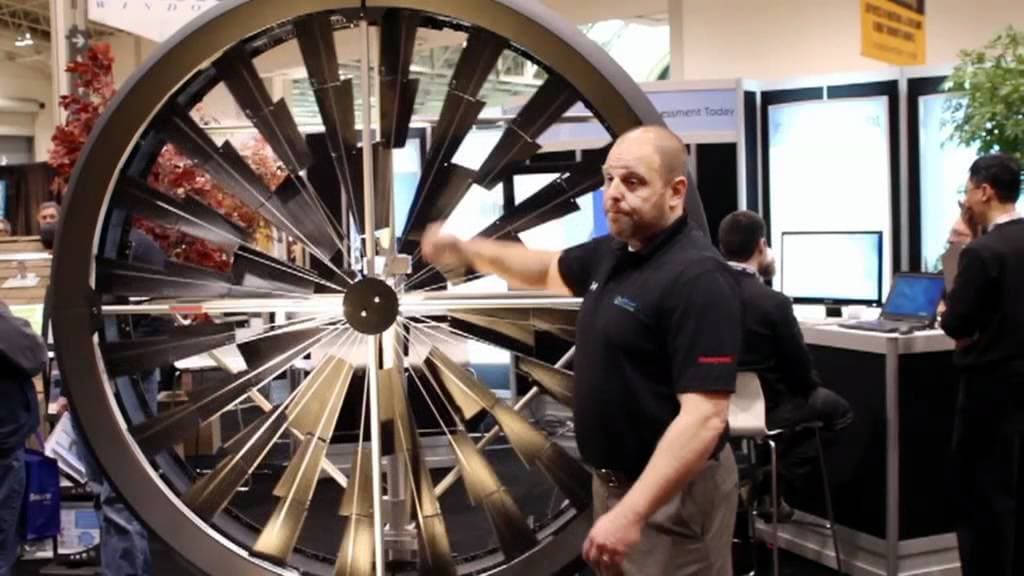No, it is just for fun. This turbine cannot orient by itself.
So I’m thinking about this: you want to wind a tether on a winch from a static point some distance from the winch. One assumes that there is a maximum deflection from vertical (from perpendicular to the winch) that the tether could have and that this is influenced by the tether tension. What is this maximum deflection and what other notable characteristics does the tether deflection have? Perhaps one could also assume that the shape of the wound tether on the winch is not flat, but crowned. What is the shape of that crown and what angle do the side walls have?
This is very easy to test, so maybe someone has experience with this, or maybe there is some theory.
I don’t understand what you’re asking
Different wording then: you’ve attached a tether around a cylinder, the tether then goes through a fixed pulley and attaches to a weight. By rotating the cylinder you can raise the weight.
I am interested in what shape the winding around the cylinder makes, most importantly how wide it is going to be. How wide it is going to be is I think a function of the tether deflection I talk about above and the distance of the pulley from the cylinder and possibly the weight of the weight.
I’d like to know this because I would like to know how close to the cylinder I can put the pulley, as the closer the better.
This is a good text. It is for wire rope however and I don’t like the very small 1.5 degrees fleet angle. Maybe for the more flexible tether you can get away with a bigger fleet angle, just like you can get away with smaller pulley sizes. IIRC minimum pulley diameter for wire ropes is something like 20 times wire diameter.
The trees were Straight yesterday, heavy cast metal outdoor furniture was standing up on concrete. Then it got windy. 22-foot diameter 10 kW wind turbine on a 120-foot tower, set sideways (furled) nonetheless kept producing more than rated power, exceeding 400 rpm (over 300 mph blade speed), multiple inverter resets, trees now set at an angle, furniture everywhere upside-down, wind turbine on 120-foot tower still intact, generating as we speak.
You might want to tie young trees to stakes when you plant them, if you now don’t.
Thanks Windy. I have hundreds of trees, on several ranch properties, many tied to stakes and poles. This particular trees is like 20 years old, and pretty big. It was ripped right out of the ground.
Yes I just saw a comment on wave energy projects citing the common adage, similar to fusion research, “It’s been right around the corner for 50 years”. I surfed a lot for years in some pretty big waves. Seems like a lot of power out there. But by this point, whenever you hear about one more wave energy project, the first reaction is Oh no, not another one - good luck with that - these things never seem to work out. The thing is, wave energy is NOT nuclear fusion. It seems like it should be fairly straightforward to develop wave energy. But it just never seems to happen. Not sure if the power is just not there, or if it is one more case of “idiots, idiots, idiots”… ![]()
Thanks to DaveS:
"
Filling a gap in AWE history:
The diagram at the bottom (after the video below) shows rigging details that we now can do far better.
[Kite Obelisk Project @ Cal-Tech EDU - YouTube]
Note starboard pilot does a kite jump at the end of video. Wild.
THE RIGGING DETAILS
Fuzzy image from broken link icon but clear enough to read the lines-
An important detail is that no one at Caltech actually believed Egyptians raised monuments by kites, that was a droll counterfactual lark to show kites could have done so.
Dave Culp, having struggled to get kite power recognized as serious since the 1970s, when he pulled a small ship by kite across San Francisco Bay, in defiance of the Oil Shock, was mortified no one would take the Obelisk feat seriously, that a few kilos of nylon lifted several tons of concrete. Behold, the Engine of the Future in ancient-alien guise.
Indeed, US Gov ignored Dave Culp. He ended his career doing ridiculously trivial research on parachute lines for the Army. To this day, DOE still prefers anything but kites flown by specialist kite energy pros to make power, but do fund inexperienced charlatans who correctly fill out the paperwork and jump thru any immaterial hoop to collect a fat check, for failing. Dave Culp came to Austin in 2006, to woo me (Dave Santos) to work in kite energy, then trained me intensively to carry on his work. DOE remains the biggest US impasse.
"
And who exactly could these “specialist kite energy pros” be? How much energy are they generating by kites right now? How much have they ever generated? What makes them “pros”? They make a living producing energy, using kites?
It almost sounds like you are talking about “idiots, idiots, idiots”…
Yes there are certain requirements to be taken seriously in any endeavor. For example, to be taken seriously in wind energy, significant levels of measured electrical output are key - if that does not happen, a project will not be taken seriously by any knowledgeable party.
And as I have long-lamented, there are a lot of hoops to jump through to get funding - but as Jesus of the bible is quoted therein to have advised, let the Romans keep their money - you don’t need it.
Anyone who really wants and really deserves funding can get it from many sources. The question is whether funding-seekers have sufficient knowledge, skill, and follow-through to be worth funding from a chance-of-success standpoint.
If someone not only has nothing compelling to offer, technologically, does not appear to understand the basics of wind energy, and has no track record of success, and is unable even to follow directions and fill out some paperwork accurately, they are unlikely to get funded - by anyone. And why would they be?
Back to the Jesus thing: If someone considers themself a “specialist kite energy pro” maybe they don’t NEED funding from entrenched government bureaucracies. Why would they let a slow-moving bureaucracy slow their rapid pace of advancement? Then again, if they are NOT advancing, maybe they can sort-of “blame” it on such a slow-moving bureaucracy, as a substitute for making any progress or generating any significant amount of power, ever. They probably don;t need funding to fail - they are perfectly capable of failing on their own - no funding needed! ![]()
(By the way, I always thought the stone blocks could have been lifted by kites to build the pyramids. Can’t remember a time when I did not think of this. I’m not talking about building a tower structure higher than an obelisk, and only then using a kite to provide a mere lifting force that could have been more easily provided by a few men pulling a rope, I’m talking about airlifting each block into place on the 400-foot-tall pyramids, using just a kite, no tower.)
That is a big problem with the circular firing squad and all the rest of the “kites to do physical work” enthusiasts: They TALK about great works kites COULD achieve, but they NEVER DO IT. You never see kites involved in timber extraction, excavation, moving water uphill - nothing. It;s all BS from a bunch of lazy BS artists who are heavy on empty “talk”, but nearly nonexistent on “action”.
I suppose if they were serious, they could easily build a scale model, put it in salt water, and see how well their idea actually works. But wait for it “Nobody will take us seriously unless we build it at utility-scale”…
Of course - the next “symptom” of “The Syndrome”
Every time I see another attempt to place a ring generator at the outer periphery of blade-travel for any turbine, whether vertical or horizontal, I think of the Honeywell failed roof-mounted turbine with its slow-speed, high-solidity rotor.
It is amazing how the same common symptoms keep rearing up, like a game of “Whack-a Mole” - the mole (symptom) comes up out of its hole so you whack it, but it just pops up again from a different hole.
If you try to tell any of these people they suffer from a well-recognized syndrome with defined symptoms, they can’t grasp what you’re talking about.
I had a guy with a sketch of an archimedian screw in a tube with a peripheral ring generator, ask for my analysis and possible partnership. It was painful to see his reaction as I tried to explain that his idea combined several known ill-advised and long-disproven “symptoms”, that it was a nice first try, but he needed to get up to speed on how wind energy worked in order to improve it.
He went berserk at the “nice try” diagnosis, dismayed that I could not understand the genius of his unassailable idea. How could I not see that the archimedian tube would suck more air through itself, magically yielding a vastly increased output (like a perpetual motion machine?) and be such a huge improvement for wind energy?
I tried to use the example of applying it to today;s utility-scale turbines at a 600-foot diameter and asked how much his tube might cost at 600 feet diameter and a half-mile long. (???)
Well of course at that point he had to admit it might be better for smaller turbines, missing the entire point that I had only mentioned today’s huge scale to illustrate the point that his design used way more material, equating to way more cost, than a regular turbine which, after 1000 years of development, uses comparatively very little material to sweep a huge area.
It would not have even made sense to try to explain how inefficient his backwards and inside-out design was, and there was no point in trying to explain any of the finer points regarding how turbines actually make power at high efficiency.
Of course he was far far away from building even the most rudimentary prototype. That;ls how he knew how much of a genius he was - no need to actually prove it - it was “obvious” from his sketch!
Like so many crackpots, he was allergic to facts, they would bounce off him like bullets bounce off Superman.
His last communication to me promised to make a video showing the world what a terrible person I was. At that point I was rolling on the ground laughing - as though this guy was EVER going to do ANYTHING but brag about what what he could not even comprehend was an idea that would use an order of magnitude more material to get an order of magnitude less power. That;s two orders of magnitude of “terrible” - like literally 100 times worse than a regular turbine.
It is all just SO PREDICTABLE - these people have nowhere to go but blame the experienced people for their own ignorance, trying to flip it over, as though they are the real authority and the experienced person just can’t understand what makes their idea so great.
Anyway, you’ve gotta appreciate the comedy. Of course, it helps to understand wind energy, in order to get the joke. ![]()
Yep, I get the Honeywell hype. I got all excited about flashy new turbine nearly a decade back. Where is it now? The only part that is remotely interested now? is the stator ring!
Going have to give top marks on picking out some of my old favourites. Just shows how bedazzled people are? when it comes to new shiny objects!
Any others you wish to mention? Any more lost to the winds?
Hi Doug, the reason why you, @Freeflying, myself and a few others like Honeywell turbine despite everything, is that the worst wind turbine is even better than the best AWES. ![]()
I really don’t know of any Honeywell turbine in operation today. Probably not designed for super-high winds which every location experiences at some point. It is literally impossible for that design to be efficient. I’m not aware of any decent output from them either - never heard anything good about one, from any knowledgeable wind person, ever. The only person I’ve ever known to say anything good about them, which was already second-hand heresay, is about the worst source of bad information about wind energy I can think of. Otherwise, never heard of one even working, nor do I know anyone who has ever even seen one. I think probably only a very few were ever made. Could be a collector’s item by now, a candidate for a future Professor Crackpot Museum of Bad Wind Energy Ideas. Either somebody talked some sense into Honeywell, or they realized how bad it was on their own. Considering all the critical aviation components they produce, they don’t need such a blemish on their reputation. But it goes to show you, even supposedly “really smart people”, if they don’t KNOW about wind energy, will fall for all the typical beginner mistakes, because wind energy is non-intuitive until you really get it under your belt. ![]()
I know this might be a Segway a little? But came around in some god forsaken hour flipped on YouTube to find this?
Considering that there were talks of co-flow jets?
Do you know of anyone using an aerospike engine setup to generate electricity? Awes or otherwise? Had seen this and it reminded me of a few things.

As far as I know awes haven’t gone down the aerospikie road? Though I could be easily wrong? It also reminds me a little of basking sharks

&
And all the fancy shaped ones?
Even making think about topping a solar towers with one of these?
Even bolting Honeywell ideas in?
Expecting crackpot diagnosis? Though with your scope? Who knows? What does @PierreB @Windy_Skies think? As slow chat veterans? Anyone else wish to chime in? Feel free to do so!
A response from Dave Santos:
Doug: “And who exactly could these “specialist kite energy pros” be?”
"
Doug asks a good question, as these pro specialists are not known outside of their elite kite design circle. As true pro status requires payment for goods or services, so here are two such kite notables for Doug to learn about.
Obviously, Dave Culp, as noted here, is a first-class power kite legend, pulling a small ship already in the 70’s, getting kites banned in America’s Cup sailing as “unfair”, and many other kite feats. Lifting a concrete monument by kite indeed requires specialized expertise armchair dreamers lack, and Culp was paid. Folks may confuse power v energy, but standing an obelisk up formally stores a bit of gravitational potential energy.
Dan Tracy is another sort of “specialist kite energy pro” that DOE NREL specifically rejected, but he pioneered a kite power ferry between Hawaiian Islands, and created the Pacific 40, the first AWES production run that sold out, one unit donated by kPower to the American Wind Power Center (Museum). These units charged batteries as a primary app.
A few more “specialist kite energy pros” could be cited, if Doug is still wanting to know who these rare folks are. On this Forum, Olivier and Roddy count, whatever Doug thinks about them being paid. DOE has not as a rule funded such folks.
Doug: It almost sounds like you are talking about “idiots, idiots, idiots”…"
Not exactly. Charlatans deserve scorn, but not our practitioner and scholarly experts in kites. Doug’s “idiots” insult is too crude for successful AWE funding scammers. “Professional criminals” is closer to the mark.
"
I remember that kite specialists in general did not have a good opinion of AWE with energy kite. I know this from having officially presented the FlygenKite (see the link below, in French language) at the 2012 Dieppe International Festival.
Ce sera aussi l’occasion de découvrir les dernières innovations, comme le “Flygen Kite”, ou l’“éolienne cerf-volant”, prototype d’éolienne conçu par Pierre Benhaïem […]
Translation:
It will also be an opportunity to discover the latest innovations, such as the “Flygen Kite”, or the “kite wind turbine”, prototype wind turbine designed by Pierre Benhaïem […]






